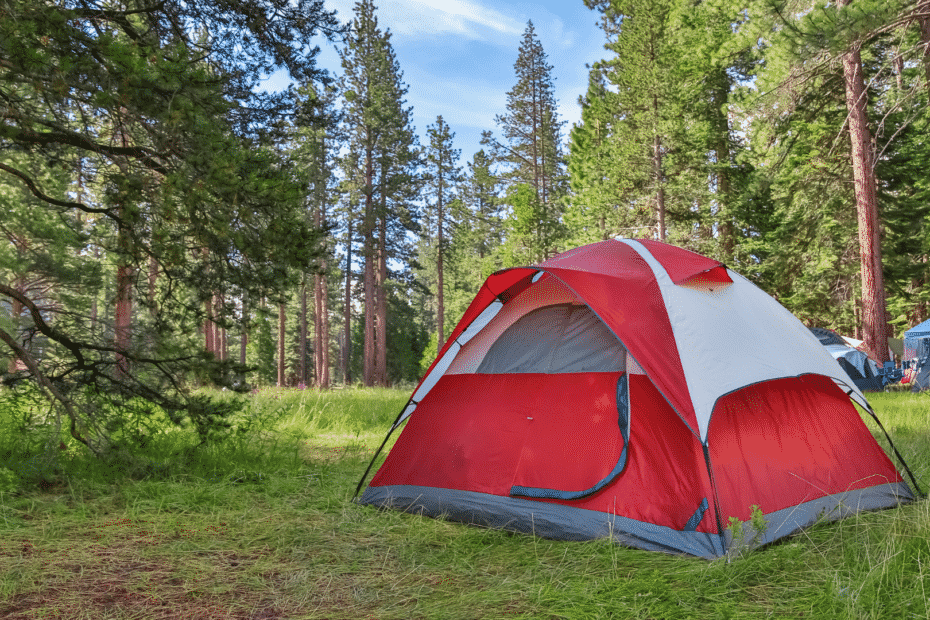There’s lots of little things that make people uncomfortable on camping trips. Although you’ll never get all the comforts of home, most problems can be solved by choosing the right gear and doing basic planning.
How do you make a tent more comfortable? Making a tent comfortable is all about optimizing your gear to suit your needs. Choose the right place to setup camp, buy the right gear and plan around the weather. You won’t get all the comforts of home, but you should be comfortable in your tent.
The outdoor industry has been working to make tent camping more comfortable for years. They keep coming out with better gear, high tech accessories, and helpful resources to make camping easy (hiking/camping apps, maps, equipment rentals, and camping guides).
The days of needing to be an expert outdoorsman are long behind us. Throughout a lifetime of camping I’ve learned that you really don’t have to sacrifice comfort when sleeping in a tent. Camping can be downright cozy with the right setup.
If you’re still nervous about sleeping outdoors, know that there are a few easy ways to make traditional tent camping downright comfortable. Not sure where to start? The following tips will lead you in the right direction.
Table Of Contents
How To Sleep Comfortably In A Tent
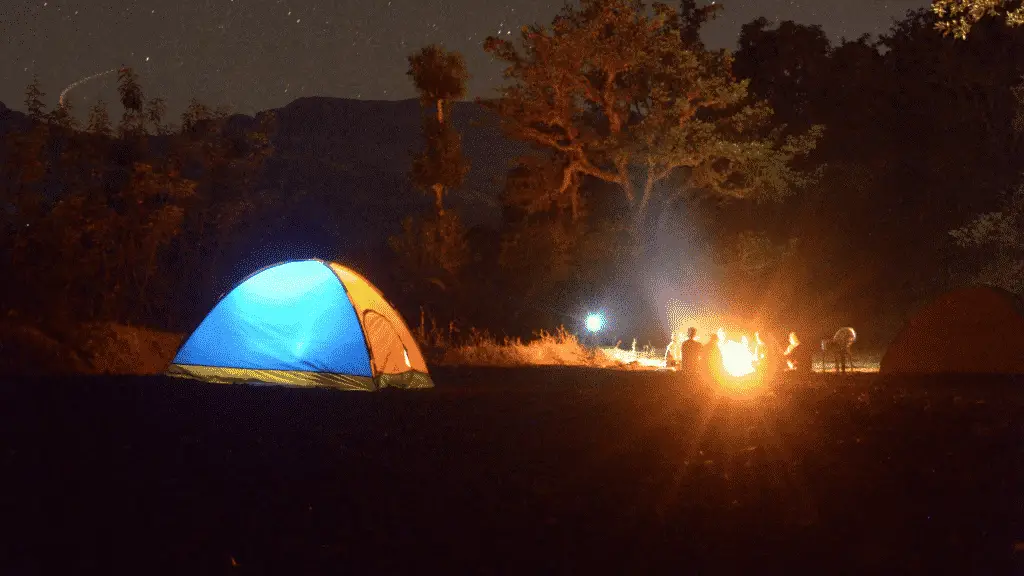
As much as I love camping there is one major drawback. Getting out into nature means you’ll have to give up the comforts of home. You’ll still have to deal with dirt, bugs, and other minor inconveniences, but that doesn’t mean you have to be uncomfortable sleeping in a tent.
Let’s start off by asking a simple question. Were you uncomfortable the last time you went camping? If so you’re doing it wrong! There’s no excuse for sleeping on the hard, damp, cold ground. With the right camping gear your tent will be far more comfortable.
It really isn’t all that difficult with a little planning and picking out the right gear. Here are a few quick tips to make tent camping a little more cozy.
- Make sure you have the right sleep system so you’re comfortable in your tent. Choose a sleeping bag that’s 15°F warmer than the expected nighttime temperature. Sleeping pads add comfort and warmth to your sleeping bag so make sure you choose a pad with a high R-Value.
- Bring extra pillows and blankets. Backpackers can find ultralight backpacking pillows that weigh under 8oz and pack small.
- Wear ear plugs and a sleep mask to bed if you like extra sleep in the mornings.
- Pack weather appropriate pajamas to stay comfortable in your tent at night. A pair of warm sweatpants or pajamas in cool weather and gym shorts in the summer.
- Try to continue following your normal routine. That includes going to bed and waking up at a normal hour so you won’t be groggy the following day.
- Choose a campsite/campground with lots of amenities to use. Look for picnic tables, firepit, BBQ Grill, wifi, and lots of activities nearby.
- Lock up your food and smellables so animals don’t tear through your tent while you’re away. Keep everything in a locked cooler or bear canister when necessary.
- Bring more clothes than you think are necessary. You will most likely get wet and dirty over the course of a camping trip so bring backup clothes to change into.
- Nobody likes hauling water around so try to find a campsite close to a water source. Most experts recommend staying at least 200ft away from local waterways to avoid contaminating water in the backcountry.
1) Choosing The Right Gear To Sleep Comfortably In A Tent
Choosing the right sleep system is by far the most important step to when it comes staying comfortable in a tent. With the right setup, you’ll be warm and up off the ground for a comfortable nights sleep.
You can’t just throw a sleeping bag down on the gravel and expect to feel comfortable. I don’t care how young you are, you’ll wake up sore and miserable. With the right gear I can almost guarantee a great nights rest.
Start With Your Sleeping Bag
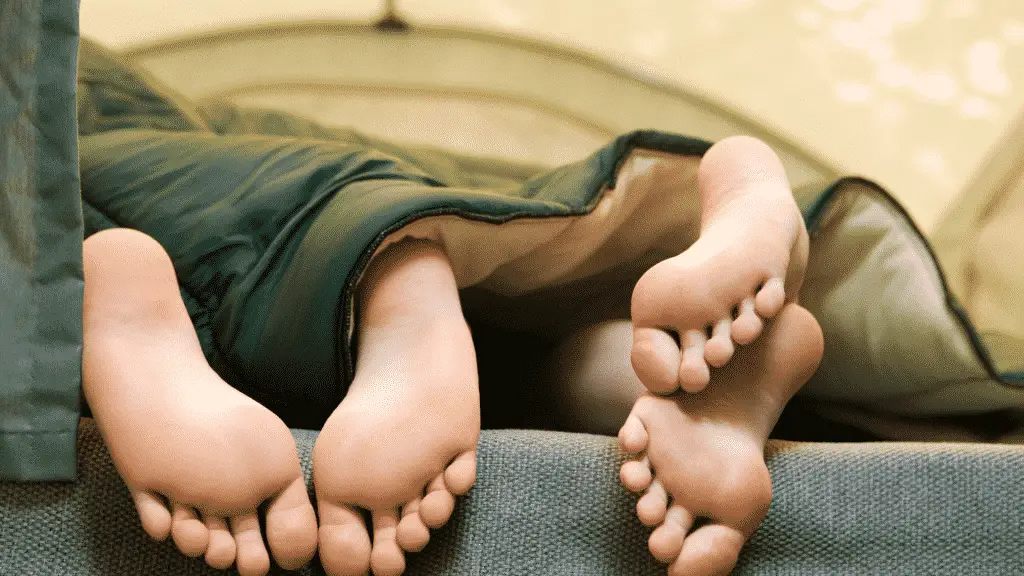
There’s nothing worse than waking up cold and miserable when camping. Every sleeping bag will have a different temperature rating. So make sure you buy a sleeping bag with a temperature rating that’s suitable for the expected nighttime temperature.
Your sleeping bag needs to be at least 15°F warmer than the expected nighttime temperatures. Sleeping bag manufacturers use deceptive temperature ratings. The advertised rating is actually the safety rating which won’t be comfortable for most people. What you need to look at is the comfort rating which is 12°-15°F cooler.
Most people can get by with a 50° sleeping bag in the summer, but you’ll need a warmer bag if you’re camping on cool spring/fall nights. You can accomplish this in one of two ways. Either buy a warmer sleeping bag with a 35° rating or pad your sleeping bags temperature rating with a liner. Even a cheap Coleman liner will add 12° to your sleeping bags temperature rating.
Different Bag Styles
- Rectangular Bag: This is the style that most of us picture when thinking of a sleeping bag. Rectangular bags offer a little more leg room and a cozier feel while sacrificing warmth. These are perfect for the vast majority of campers during the heat of summer.
- Mummy Bag: Mummy bags are going to be both lighter and warmer than rectangular bags. Designed for backpackers, these bags offer a ton of warmth for the weight.
- Double Bag: Double bags are about the size of a full size bed allowing two people to snuggle up together.
Sleeping Bag Liners Add Versatility
I’m a firm believer that everybody should purchase a 3-Season sleeping bag and pair it with a sleeping bag liner. A 30 degree sleeping bag paired with a good liner can keep you warm in the vast majority of situations.
Sleeping bag liners serve two primary purposes. They protect your sleeping bag from dirt, sweat, body oils, etc. and add warmth to your bag. Using a sleeping bag liner will significantly extend the life of your bag since you won’t have to wash it as frequently.
Every time you wash your bag the insulation packs down and reduces the temperature rating. Less wash cycles equals a longer lasting bag. There’s really no downside to using a liner so I highly recommend picking one up.
For the past couple seasons I’ve been using the Sea to Summit Reactor Extreme sleeping bag liner. In the summer I ditch my sleeping bag and use the bag liner by itself and in the winter it adds about 25 degrees of warmth to my sleeping bag.
You can even go with a cheap bag liner (like this one) and get most of the benefits. It’s going to add about 10 degrees to your bag and protect it against dirt/debris.
Get a Sleeping Pad or Air Mattress
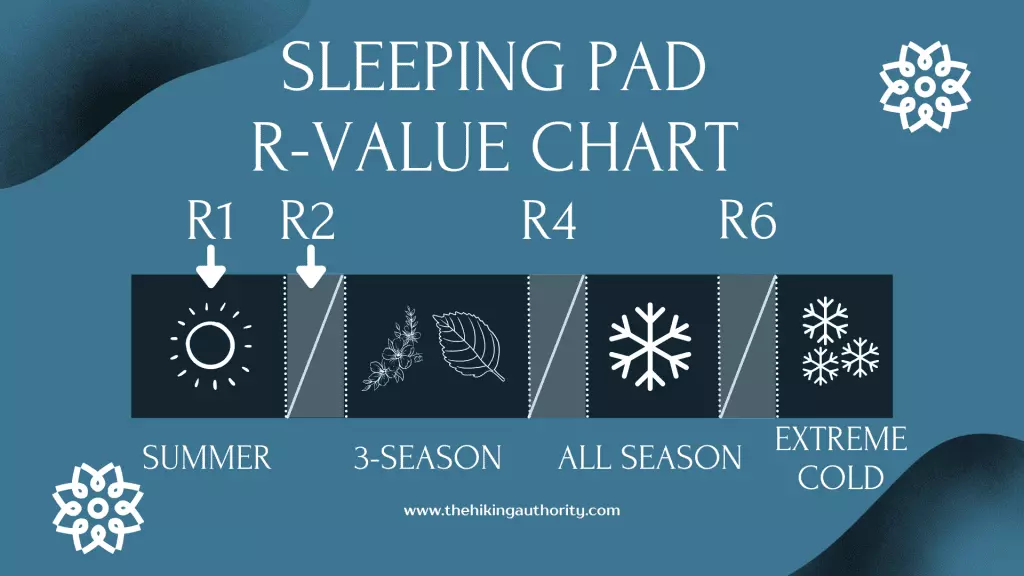
People who say sleeping pads aren’t necessary are either young or out of their minds. Your bed at home might not technically be necessary, but it sure is nice. Sleeping pads offer protection from the cold ground and get your back up off the hard ground.
Unless you’re a serious backpacker or camp regularly you can probably get away with a typical air mattress. You can fit a full size air mattress inside most tents. Just make sure there aren’t any sticks/rocks underneath your tent.
You just want to have a barrier between your body and the cold hard ground. It doesn’t matter if it’s a air mattress, Sleeping Pad (this is the one I use) or cheap foam pad (my cheap foam pad). Doesn’t matter what style you use just make sure you’re up off the ground and it has an R-Value suitable for the weather.
Look at the R-Value chart above before picking out a sleeping pad. As a general rule, you need a 3-4 R-Value pad for the spring/fall and 4+ R-Value pad in the winter. You can use whatever pad is comfortable in the summer since the ground won’t be cold.
Different Sleeping Pads
- Closed-Cell Pads: Closed-cell pads are the most basic style sleeping pad you can find. They’re lightweight, cheap and extremely affordable. They might not be the most comfortable, but they’re better than nothing.
- Self-Inflating Pads: Self-Inflating Pads are going to be fairly inexpensive and offer a ton of warmth. Only problem is they puncture easily.
- Air Pads: Most serious backpackers and campers choose air pads. Air pads are extremely comfortable, lightweight and offer excellent insulation from the cold. The only problem is they’re pretty expensive(check out the price of my favorite pad).
2) Bring Extra Pillows and Blankets To Be Cozy At Night

If you have a long hike into camp you’re gear will be somewhat limited. Pillows and extra blankets won’t make the cut. If you’re camping near the parking lot a few extra pillows and blankets are a great idea.
Backpackers will be limited with how much gear they can carry. A small backpacking air pillow or travel pillow is a great addition to your pack. I really like my Therm-a-Rest Compressible travel pillow, but it will add a few oz to your pack.
Ultralight guys might look down on bringing a pillow, but the little things make a big difference on the trail. A 7 oz pillow like mine isn’t going to kill you. I’m willing to bet that sleeping with a pillow helps my back more than the added weight hurts it.
Carrying extra blankets adds versatility and padding to your sleep system. Once again, backpackers won’t be able to carry extra blankets, but a quality sleeping bag liner will help with versatility. It will increase the temperature rating in your bag and allow you to zip/unzip your bag depending on the temperature.
My sea to summit sleeping bag liner adds 25 degrees to my sleeping bags temperature rating. It gets used all by itself in the summer and it extends the temperature rating of my bag in the winter.
3) Get More Sleep With A Mask and Ear Plugs

Honestly, I can’t remember the last time I woke up before the sun came up. Actually I can, it was the last time I went camping. If you work second/third shift like I do you need to bring along eye masks and ear plugs.
When the sun rises before 6am it can be hard to get a good nights sleep. With a eye mask and ear plugs you can sleep in as late as you want. The only problem with this is your tent will quickly get hot as the sun rises in the morning.
Your tent will turn into a sauna if all the door and windows are closed. Choose a well ventilated 3-Season tent and use a small battery operated fan to help circulate the air. This will also help reduce condensation so it serves multiple purposes.
4) Wear Comfortable Camping Pajamas
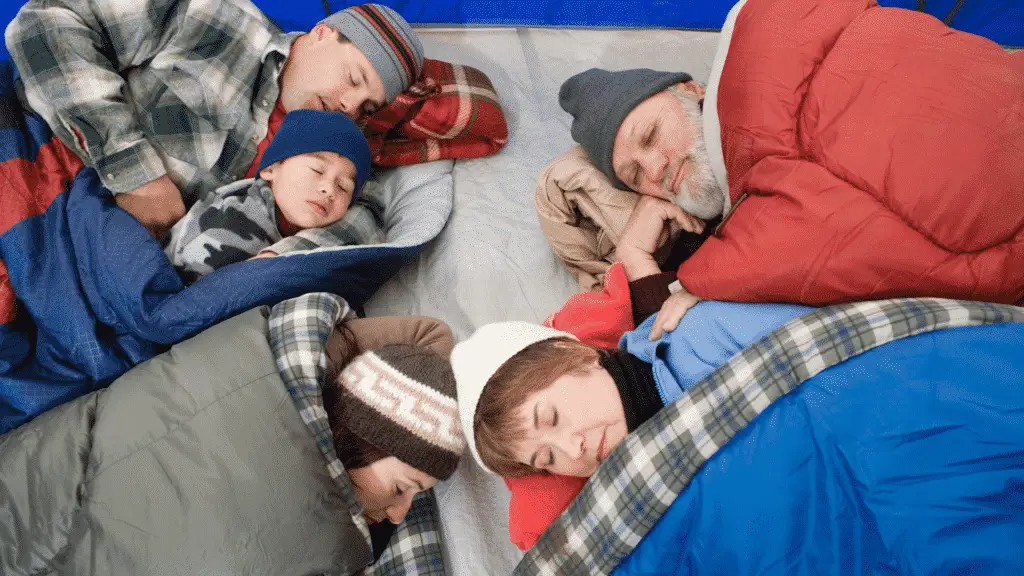
Nowadays there’s no excuse to ever be cold on a camping trip. Being cold only means your sleep systems wrong or you’re not layering your sleeping clothes before crawling into bed. I explained how to choose the right sleeping bag/pad above so lets get into camping pajamas.
What should you wear in a sleeping bag while camping? It all depends on your sleeping bag and the night time temperatures. Choosing camping pajamas in the summer is easy. Wear gym shorts or underwear and a t-shirt. That’s all you need to be comfortable!
Problems start to arise during the spring and fall when there’s severe temperature swings. It can be 80 degrees during the day and drop into the 40’s at night. Temperature swings from one day to the next further complicate matters.
I like to bring a pair of gym shorts for hanging around camp and slip into sweat pants or pajamas as the sun goes down. It’s always better to be a little bit warm than freezing cold. Just unzip your sleeping bag to let in a cool breeze if you get too hot at night.
5) Practice Your Normal Routine

Just because you’re camping doesn’t mean you need to abandon your regular routine. Obviously, you can’t keep the exact same schedule, but you shouldn’t throw everything you normally do out the window.
If everyday you wake up, have a cup of coffee and make breakfast that’s exactly what you should do on a camping trip. I actually bought a small propane coffee maker that makes a 10 cup pot of coffee (check it out). It’s the little things that improve your overall comfort.
The same concept should be applied at night. You probably have a nighttime routine at home that should be continued while camping in a tent. Do you normally read before bed? Bring along a spare lamp and a book. Practice the same bedtime routine that you normally follow.
6) Choose A Campsite With The Comforts Of Home
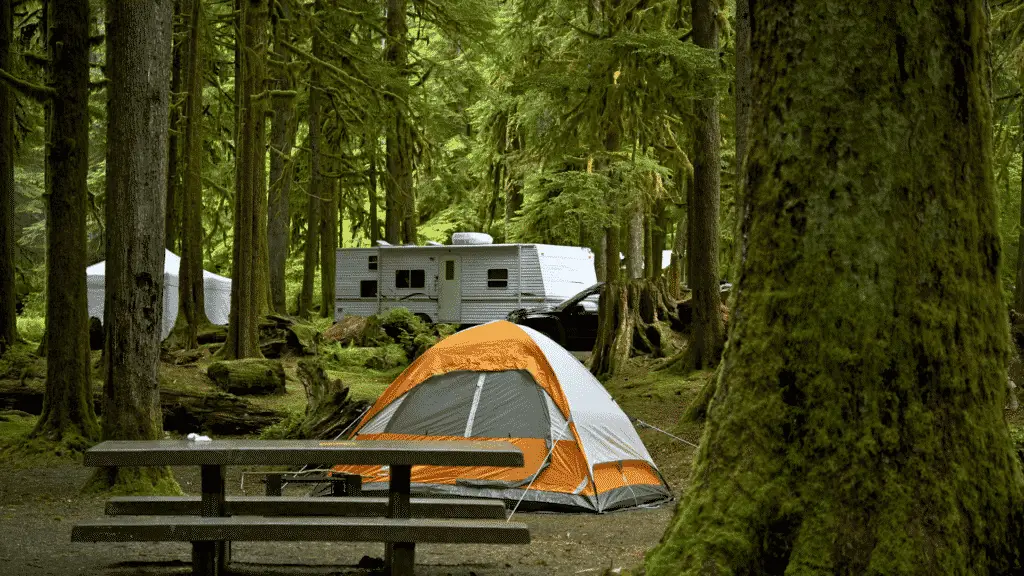
Do yourself a favor and put a little thought into your campsite. Make sure you find a level and dry spot to pitch your tent. Never setup camp in a ditch or bottom of a hill where water pools.
If you’re staying in a public campground look for picnic tables, fire rings and close proximity to showers and restrooms. You need a plan for those late night bathroom runs. You’ll be running to the bathrooms regularly with young children.
Pay attention to the other campers surrounding your site. Do they look like hard partyers or parents with loud children? Unless it’s a busy weekend you might be able to move to another site.
7) Keep Animals Away From Your Food

Never store food inside your tent! Storing food inside your tent almost guarantees critters nearby. Nobody wants raccoons, rodents and squirrels invading their campsite.
Locking coolers will work with most animals and they should be kept away from your tent. If the parking lot is nearby you can lock up a cooler in the trunk. Just make sure you have a bunch of ice.
In bear country you need to be even more careful. Bears can smell food from miles away and you don’t want them invading your campsite. When camping with bears all food should be kept in locking bear container or designated lock box.
8) Pack For The Weather
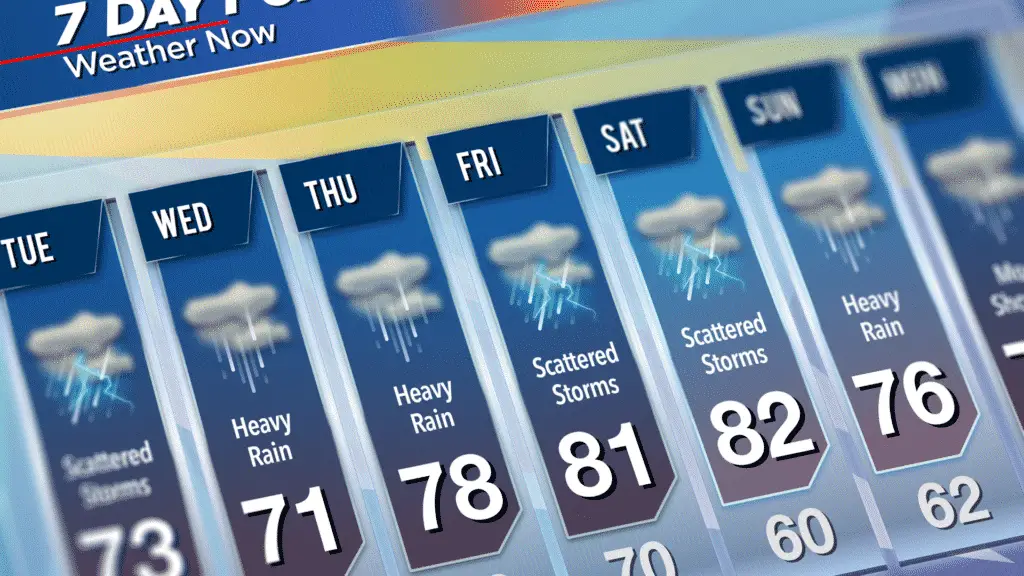
Try to pack more clothing than you think you’ll need. You never know what’s going to happen on a camping trip. The weather changes on a dime and you never know when you’ll get soaked or muddy. At the very least bring some rain gear and a light jacket just in case.
After a long hike you’re going to be dirty and sweaty. Nobody wants to sleep in the nasty clothes that they hiked in. Bring a change of clothes so you don’t have to sleep in grungy clothing.
Personally, I like to sleep in the same clothes I wear to bed at home. I normally sleep in my boxer briefs, but I always bring along a pair of sweats as well. Some people even swear by sleeping in the nude, but I’m not a fan. (check out my post on why you shouldn’t sleep naked in a sleeping bag).
Whatever you do don’t wear too many layers to bed. On those cold nights you might be tempted to throw on a ton of layers, but you’ll just end up sweaty. Sleeping bags are made to trap body heat so just let it do its job.
9) Stay Close To A Water Source
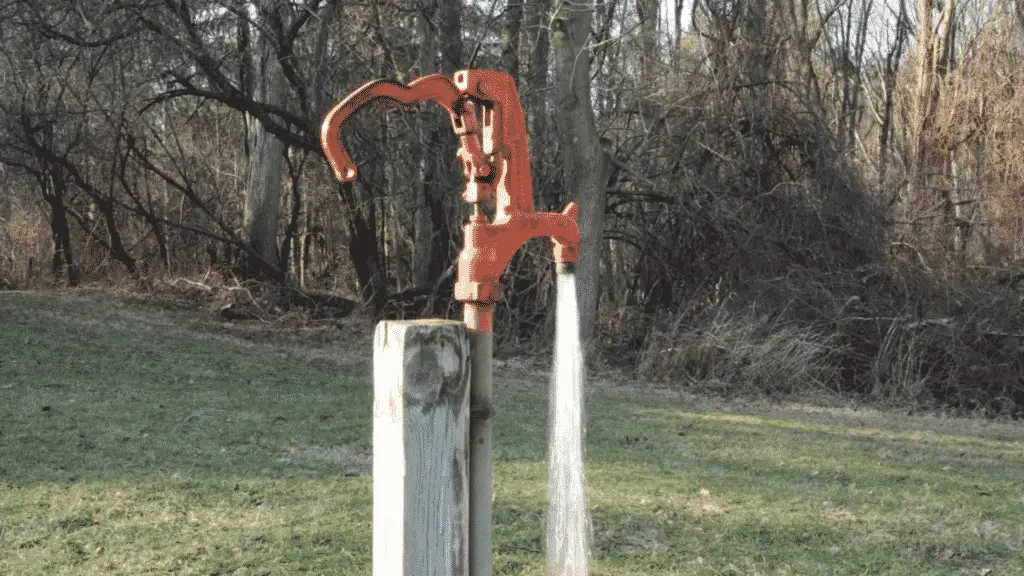
You’d be amazed at how much water you go through on a weekend camping trip. Somehow my family of four went through over 25 gallons of water on our last weekend trip. With young kids we went through a lot of water, but that’s a lot of trips to the bath house for water.
Remember, that water isn’t just going to be used for drinking. It’s used for cooking, cleaning and basic hygiene. You will go through way more water than you’d think.
Bonus: Have a Bathroom Plan
This is more of a bonus tip since it goes with staying close to a water source. What’s the first thing you do after waking up? Almost everybody pees right after they wake up!
You need to have a plan in place for early morning/midnight bathroom runs. This is especially important when camping with young children.
There’s not much you can do if you’re camping with young children. They’re going to need to pee at the worst possible time. Your best bet is to setup camp close to the bathroom.
Limit water intake and try to use the bathroom a couple time before heading to bed so you don’t have to get up.
Trust me, it’s a real pain to put on your shoes and walk to the bath house. Set out a pair of sandals and warm clothes so you aren’t messing around in the dark.
